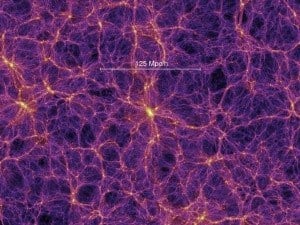Cosmologists have established that much of the stuff of the universe is made of dark matter, a mysterious, invisible substance that can’t be directly detected but which exerts a gravitational pull on surrounding objects. Dark matter is thought to exist in a vast network of filaments throughout the universe, pulling luminous galaxies into an interconnected web of clusters, interspersed with seemingly empty voids.
Researchers at the University of Pennsylvania have measured the “weight” of these cosmic voids and filaments for the first time, showing the former are not as empty as they look.
The studies of voids and filaments are currently available on the ArXiv and were conducted by graduate student Joseph Clampitt and professor Bhuvnesh Jain of the Department of Physics and Astronomy in Penn’s School of Arts & Sciences.
Gravitational lensing, the tiny distortions of distant galaxy images due to intervening matter, allows scientists to weigh galaxies by measuring how much their light bends. Voids, on the other hand, are enormous, seemingly empty spaces in the universe with scarcely any galaxies visible — an arrangement that makes measuring their contents through lensing more difficult.
While galaxies and filaments have more mass than the average regions of the universe, voids have less mass than average. This unbalanced distribution causes matter to rapidly move away from voids and towards the concentrations of mass along the cosmic filaments that lie between them.
“This means that voids act like objects with an effectively negative mass,” Clampitt said, “such that even light rays bend away from them. They act roughly like concave lenses, the opposite of big galaxies, which act like convex lenses.”
Clampitt and Jain detected the tiny distortions produced by voids on the images of nearly 40 million galaxies in the Sloan Digital Sky Survey. This breakthrough came just a few months after they, along with Masahiro Takada of Tokyo University’s Institute for the Physics and Mathematics of the Universe, detected the lensing signal from the dark matter filaments that connect galaxies.
“The measurements came as a wonderful surprise,” Jain said. “Theoretical studies had predicted that we’d have to wait for much bigger surveys well into the future to detect void lensing. Joseph’s ingenious analysis techniques extracted a subtle signal no one had seen before.”
The team’s trick to wringing these measurements out of existing data was a new way of processing the images of galaxies. The images from the Sloan Digital Sky Survey contain distortions from the atmosphere and telescope imperfections that are larger than the cosmological signal the researchers aimed to detect. Exploiting symmetries of the lensing effect, they were able suppress these terrestrial distortions so the ones stemming from the cosmic voids and filaments were clearer.
Their results show that voids are not as empty as they appear. Dark matter and other dim structures permeate all the way to the center of the voids.
“Although the density of this matter is far less than average,” Clampitt said, “it is somewhat surprising that the voids are not as empty as the galaxy distribution suggests.”
“The density at the center of a typical void,” Jain said, “is about half the mean density in the universe, but that still leaves the voids with an enormous deficit in mass, about a thousand trillion times the mass of the sun.” The research was supported by the U.S. Department of Energy and National Science Foundation.



In general people can’t relate to what they cannot see. Due to previous research I have learned that the first telescope that will be able to accurately map the Cosmic web will be the Square Kilometre Array (SKA). I believe that after analyzing the images and information received from this telescope the subject of dark matter and the Cosmic web will become much clearer.
Reading this blog made me realize that the Universe is a lot bigger that what I initially thought it was. To me the most significant part of this blog is the fact that technology has developed so vastly that it now enables us to actually determine the mass of the universe by measuring how much light is bent. Also it was amazing to find out that that which we thought was nothing but empty space has been measured and is something called dark matter that contains an enormous amount of mass. I learned that although dark matter has a density much less than the average density of the universe it is not quite as empty as it might appear to be. I always believed that the sun had a relatively large mass but shockingly enough after reading this blog I discovered that the mass of voids in the universe are a thousands trillion times more. Even though reading this blog made me feel so small in comparison to this huge universe we are living in, it also made me appreciate the Creator of it all even more.
It is amazing how the light and lensing effects can be used to determine the mass of voids which is not as empty as it seems. In this article empty spaces and their masses are broadly discussed and extended my knowledge regarding this spesific topic. The link to gather more information on certain words as well as the experiment was very helpful as well as it enabled me to learn more about this interesting topic
The word, void, literally means empty space. Voids are supposed to be places in the universe that has no mass, but instead these scientists found evidence that voids are not just empty space, but that voids actually have mass. The scientists discovered that voids have mass, due to the fact that light bends when it comes in to contact with dark matter. If this is true, then this is experimental evidence that dark matter really exists and that the mass of dark matter can be determined. If this is true, then where did dark matter come from and what are the properties of dark matter?